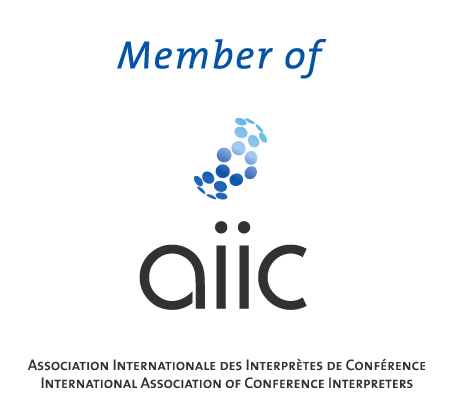Interpreting
Unlike the written transfer of words into another language – referred to as translation –interpreting involves the transfer of the spoken word from one language into another. Let’s discuss your exact needs, then choose the mode of interpreting that is best suited to the event you are planning.
Simultaneous interpreting
The interpreter speaks virtually at the same time as the speaker, while those requiring interpretation listen via an infrared receiver plus headset or an online stream. Simultaneous interpreters usually work in a soundproof environment in teams of two, sometimes three, from a foreign language into their mother tongue and/or the other way around. If additional languages are to be covered, the corresponding number of additional interpreters and booths will be needed. The advantage of simultaneous interpreting is that no time is lost, and all participants can use their mother tongue to communicate provided simultaneous interpretation is offered in their languages.
This mode of interpreting is ideal for larger events, conferences, workshops and training sessions.Whispered interpreting
Also known as chuchotage, with this technique the interpreters work simultaneously, but – unlike in an interpreting booth – do not necessarily use headsets to listen to the speaker. Instead, they are in the room listening to the speaker along with the other participants. On the one hand, this makes it harder for the interpreters to hear the speaker; on the other, it requires the participants to observe discipline since interpreters can only ever interpret one conversation at a time. Also, background noise can make it harder – or even impossible – for them to do their job. This mode of interpreting, too, typically involves interpreters working in teams of two.
The use of portable simultaneous interpreting equipment allows for whisper interpreting to be provided for smaller groups of up to 15 participants and informal meetings with a limited timeframe of a couple of hours. Participants listen to the interpretation via headset. However, note that even if the interpreters are doing their best to speak quietly, it is inevitable that those not requiring interpretation will also hear the voice of the interpreter who, after all, is in the same room. Some may find this background noise irritating.
Without portable equipment, this mode of interpreting is only suitable for two to three individuals who sit either directly in front of or next to the interpreter.Consecutive interpreting
The interpreter notes down longer passages as presented by the speaker before interpreting them into the foreign language consecutively, i.e., while the speaker pauses. No technical equipment is needed for this, but this mode does ensure strict time management as it requires close to twice the time needed in comparison with simultaneous interpreting.
Possible scenarios include depositions or after-dinner speeches.Liaison interpreting
The interpreter consecutively renders the speaker’s words in short units of meaning without taking notes. Depending on the size and setting of the meeting, a mix of interpreting modes may be called for.
This is suitable for small-scale meetings, video conferences and conference calls with a high level of interaction between participants.



